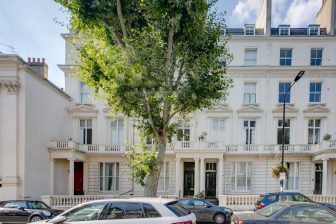 House prices across the UK’s increasingly price sensitive prime markets nudged down for a fourth consecutive quarter in the three months to the end of September, taking annual falls to an average of 5.2%, according to the Savills quarterly prime residential index.
House prices across the UK’s increasingly price sensitive prime markets nudged down for a fourth consecutive quarter in the three months to the end of September, taking annual falls to an average of 5.2%, according to the Savills quarterly prime residential index.
By contrast, values at the top end of Scotland’s housing market held steady in the quarter, leaving them an average of just 1.1% down year-on-year.
The mini budget of September 2022 signalled an end to more than two years of strong house price growth across the UK’s prime markets, broadly the top 5% to 10% of homes by value. Since then, rising interest rates and wider inflationary pressures have chipped away at buyers’ budgets, particularly those dependent on borrowing.
Some of the gains of the past few years have been eroded, but the prime markets are underpinned by deep reserves of equity and relatively constrained stock levels in many locations, so values remain on average 10.5% up on March 2020.
In Scotland, which emerged later from the pandemic restrictions, house prices in prime markets are 16.1% higher than in March 2020 – making it the strongest performing region in the UK, albeit the market is increasingly driven by best in class properties and realistic pricing is required to achieve a sale, as across the rest of the UK.
A home bought just before the first lockdown for £1,000,000 may have peaked in value at £1,166,000 a year ago as a prime UK average, it is still worth £1,105,000 today, an overall gain of £105,000. In Scotland that gain peaked at £174,000 and now stands at £161,000. The greatest gain was made across the wider South, peaking at £192,000 in September 2022, though that has fallen to £134,000 in the past year.
| Prime suburbs | Prime inner commute | Prime outer commute | Prime wider south | Prime Midlands/North | Prime Scotland | Prime Wales | All Prime UK | |
| Quarterly growth | -2.1% | -1.8% | -1.6% | -1.5% | -1.0% | -0.1% | -1.1% | -1.5% |
| Annual growth | -7.1% | -6.9% | -6.5% | -4.9% | -2.9% | -1.1% | -3.4% | -5.2% |
| Since Mar-20 | 10.1% | 7.0% | 8.3% | 13.4% | 10.5% | 16.1% | 6.1% | 10.5% |
Source: Savills prime regional index, Q3 2023
“Broadly speaking, prime markets furthest from London are holding up the strongest, with suburban and commuter belt markets coming under the greatest pressure,” said Frances McDonald, director, Savills residential research. “These higher value, more mortgage dependent markets, which saw an influx of buyers from London over the past couple of years, are more exposed to affordability pressures and higher costs of commuting, amongst other factors.”
While there are exceptions, such as Beaconsfield and Henley, the suburbs and commuter belt around London are feeling the squeeze of higher borrowing costs. These markets, popular with young professionals and families leaving London for more space, saw values fall between 6.5% and 7.1% during the past year, against an average of just -2.1% across prime London, Savills reports.
“Across the market as a whole, lower value properties are showing most price resilience, a clear signal that the prime markets – though driven in large part by cash and equity – are not immune to the rising cost of borrowing and the wider macroeconomic backdrop.”
Analysis from Savills shows that cash is an increasingly important feature of the prime market in all regions, with mortgage-free and low loan to value purchases accounting for a larger share of all transactions in the face of rising borrowing costs.
“Beyond prime central London, the lowest levels of mortgage use has been across the wider South of England, at just 31%,” said McDonald. “Here, a high concentration of equity rich buyers – including downsizers – mean many are electing to buy without borrowing. London’s hinterland has the highest levels of borrowing, albeit the suburbs and inner commuter belt have seen the biggest falls in the use of mortgages over the past year as affordability pressures bite.”
| % buyers using a mortgage | All prime London | Prime suburbs | Prime inner commute | Prime outer commute | Prime wider south | Prime Midlands/
North |
Prime Scotland |
| 2020-2022 | 53% | 66% | 63% | 54% | 33% | 50% | 35% |
| January-August 2023 | 42% | 51% | 54% | 47% | 31% | 43% | 40% |
Source: Savills
The Cotswolds and prime coastal locations saw headline-grabbing price growth during the lockdown ‘race for space’ but are now behaving somewhat differently. The Cotswolds, which is within part time commuting distance from London and still stock-constrained, house prices are down 3.4% year-on-year, but the average prime coastal value is down 6.4%.
The revival of large country house living was one of the biggest stories of the pandemic, but a gradual return to more normal working patterns has eroded some of the pandemic premium over the past year, particularly in markets that attracted buyers relocating from London.
Country house values are down 5.7% year-on-year across the UK as a whole, with falls almost in double digits (-9.4%) in the South East. By contrast, the relative value on offer in Scotland means prices are down just 1% year-on-year.
Phillippa Dalby-Welsh, head of the country house team at Savills, commented. “Vendor expectations remain high, especially among the discretionary movers. This means realistic pricing is required to get a sale over the line unless a house represents absolute best in class for the location, in which case it’s possible to buck the trend.”


Comments are closed.